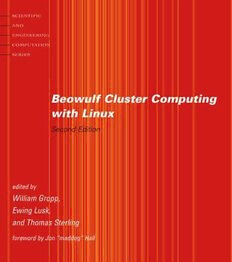Table Of ContentScientific and Engineering Computation
Janusz Kowalik, editor
Data-ParallelProgrammingonMIMDComputers,PhilipJ.HatcherandMichaelJ.Quinn,1991
Unstructured Scientific Computation on Scalable Multiprocessors,editedbyPiyushMehrotra,
JoelSaltz,andRobertVoigt,1992
Parallel Computational Fluid Dynamics: Implementation and Results,editedbyHorst
D.Simon,1992
Enterprise Integration Modeling: Proceedings of the First International Conference,editedby
CharlesJ.Petrie,Jr.,1992
The High Performance Fortran Handbook,CharlesH.Koelbel,DavidB.Loveman,Robert
S.Schreiber,GuyL.SteeleJr. andMaryE.Zosel,1994
PVM: Parallel Virtual Machine–A Users’ Guide and Tutorial for Network Parallel Computing,
AlGeist,AdamBeguelin,JackDongarra,WeichengJiang,BobManchek,andVaidySunderam,
1994
Practical Parallel Programming,GregoryV.Wilson,1995
Enabling Technologies for Petaflops Computing,ThomasSterling,PaulMessina,andPaul
H.Smith,1995
An Introduction to High-Performance Scientific Computing,LloydD.Fosdick,Elizabeth
R.Jessup,CarolynJ.C.Schauble,andGittaDomik,1995
Parallel Programming Using C++, editedbyGregoryV.WilsonandPaulLu,1996
Using PLAPACK: Parallel Linear Algebra Package,RobertA.vandeGeijn,1997
Fortran95Handbook,JeanneC.Adams,WalterS.Brainerd,JeanneT.Martin,BrianT.Smith,
JerroldL.Wagener,1997
MPI—The Complete Reference: Volume 1, The MPI Core,MarcSnir,SteveOtto,Steven
Huss-Lederman,DavidWalker,andJackDongarra,1998
MPI—The Complete Reference: Volume 2, The MPI-2 Extensions,WilliamGropp,Steven
Huss-Lederman,AndrewLumsdaine,EwingLusk,BillNitzberg,WilliamSaphir,andMarcSnir,
1998
A Programmer’s Guide to ZPL, LawrenceSnyder,1999
How to Build a Beowulf, ThomasL.Sterling,JohnSalmon,DonaldJ.Becker,andDaniel
F.Savarese,1999
Using MPI: Portable Parallel Programming with the Message-Passing Interface,secondedition,
WilliamGropp,EwingLusk,andAnthonySkjellum,1999
Using MPI-2: Advanced Features of the Message-Passing Interface,WilliamGropp,Ewing
Lusk,andRajeevThakur,1999
Beowulf Cluster Computing with Linux,ThomasSterling,2001
Beowulf Cluster Computing with Windows,ThomasSterling,2001
Beowulf Cluster Computing with Linux
Thomas Sterling
The MIT Press
Cambridge, Massachusetts
London, England
(cid:1)c 2002MassachusettsInstituteofTechnology
Allrightsreserved. Nopartofthisbookmaybereproducedinanyformbyanyelectronicor
mechanicalmeans(includingphotocopying,recording,orinformationstorageandretrieval)
withoutpermissioninwritingfromthepublisher.
ThisbookwassetinLATEXbytheauthorandwasprintedandboundintheUnitedStatesof
America.
LibraryofCongressControlNumber2001095383
ISBN:0–262–69274–0
Disclaimer:
Some images in the original version of this book are not
available for inclusion in the eBook.
Dedicated with respect and appreciation to the memory of
Seymour R. Cray
1925–1996
Contents
Series Foreword xix
Foreword xxi
Preface xxix
1 Introduction—Thomas Sterling 1
1.1 Definitions and Taxonomy 1
1.2 Opportunities and Advantages 3
1.3 A Short History 6
1.4 Elements of a Cluster 8
1.5 Description of the Book 10
I Enabling Technologies
2 An Overview of Cluster Computing—Thomas 15
Sterling
2.1 A Taxonomy of Parallel Computing 16
2.2 Hardware System Structure 19
2.2.1 Beowulf Compute Nodes 19
2.2.2 Interconnection Networks 23
2.3 Node Software 25
2.4 Resource Management 25
2.5 Distributed Programming 27
2.6 Conclusions 29
3 Node Hardware—Thomas Sterling 31
3.1 Overview of a Beowulf Node 32
3.1.1 Principal Specifications 34
3.1.2 Basic Elements 35
3.2 Processors 38
3.2.1 Intel Pentium Family 39
3.2.2 AMD Athlon 39
3.2.3 Compaq Alpha 21264 40
viii Contents
3.2.4 IA64 40
3.3 Motherboard 41
3.4 Memory 43
3.4.1 Memory Capacity 43
3.4.2 Memory Speed 43
3.4.3 Memory Types 44
3.4.4 Memory Hierarchy and Caches 45
3.4.5 Package Styles 46
3.5 BIOS 46
3.6 Secondary Storage 47
3.7 PCI Bus 49
3.8 Example of a Beowulf Node 50
3.9 Boxes, Shelves, Piles, and Racks 50
3.10 Node Assembly 52
3.10.1 Motherboard Preassembly 53
3.10.2 The Case 54
3.10.3 Minimal Peripherals 55
3.10.4 Booting the System 56
3.10.5 Installing the Other Components 57
3.10.6 Troubleshooting 59
4 Linux—Peter H. Beckman 61
4.1 What Is Linux? 61
4.1.1 Why Use Linux for a Beowulf? 61
4.1.2 A Kernel and a Distribution 64
4.1.3 Open Source and Free Software 65
4.1.4 A Linux Distribution 67
4.1.5 Version Numbers and Development Methods 69
4.2 The Linux Kernel 71
4.2.1 Compiling a Kernel 72
4.2.2 Loadable Kernel Modules 73
4.2.3 The Beowulf Kernel Diet 74
4.2.4 Diskless Operation 76
Contents ix
4.2.5 Downloading and Compiling a New Kernel 77
4.2.6 Linux File Systems 79
4.3 Pruning Your Beowulf Node 82
4.3.1 inetd.conf 83
4.3.2 /etc/rc.d/init.d 83
4.3.3 Other Processes and Daemons 85
4.4 Other Considerations 86
4.4.1 TCP Messaging 87
4.4.2 Hardware Performance Counters 88
4.5 Final Tuning with /proc 88
4.6 Conclusions 92
5 Network Hardware—Thomas Sterling 95
5.1 Interconnect Technologies 95
5.1.1 The Ethernets 96
5.1.2 Myrinet 97
5.1.3 cLAN 98
5.1.4 Scalable Coherent Interface 99
5.1.5 QsNet 99
5.1.6 Infiniband 100
5.2 A Detailed Look at Ethernet 100
5.2.1 Packet Format 100
5.2.2 NIC Architecture 102
5.2.3 Hubs and Switches 105
5.3 Network Practicalities: Interconnect Choice 106
5.3.1 Importance of the Interconnect 106
5.3.2 Differences between the Interconnect Choices 107
5.3.3 Strategies to Improve Performance over Ethernet 108
5.3.4 Cluster Network Pitfalls 109
5.3.5 An Example of an Ethernet Interconnected Beowulf 110
5.3.6 An Example of a Myrinet Interconnected Cluster 111
6 Network Software—Thomas Sterling 113
x Contents
6.1 TCP/IP 113
6.1.1 IP Addresses 114
6.1.2 Zero-Copy Protocols 115
6.2 Sockets 116
6.3 Higher-Level Protocols 120
6.3.1 Remote Procedure Calls 121
6.3.2 Distributed Objects: CORBA and Java RMI 123
6.4 Distributed File Systems 126
6.4.1 NFS 126
6.4.2 AFS 127
6.4.3 Autofs: The Automounter 128
6.5 Remote Command Execution 128
6.5.1 BSD R Commands 128
6.5.2 SSH—The Secure Shell 130
7 Setting Up Clusters: Installation and 131
Configuration—Thomas Sterling and Daniel Savarese
7.1 System Access Models 131
7.1.1 The Standalone System 132
7.1.2 The Universally Accessible Machine 132
7.1.3 The Guarded Beowulf 132
7.2 Assigning Names 133
7.2.1 Statistically Assigned Addresses 133
7.2.2 Dynamically Assigned Addresses 134
7.3 Installing Node Software 135
7.3.1 Creating Tar Images 136
7.3.2 Setting Up a Clone Root Partition 137
7.3.3 Setting Up BOOTP 138
7.3.4 Building a Clone Boot Floppy 139
7.4 Basic System Administration 140
7.4.1 Booting and Shutting Down 140
7.4.2 The Node File System 141
Contents xi
7.4.3 Account Management 142
7.4.4 Running Unix Commands in Parallel 143
7.5 Avoiding Security Compromises 144
7.5.1 System Configuration 144
7.5.2 Restricting Host Access 145
7.5.3 Secure Shell 146
7.5.4 IP Masquerading 147
7.6 Job Scheduling 149
7.7 Some Advice on Upgrading Your Software 150
8 How Fast Is My Beowulf?—David Bailey 151
8.1 Metrics 151
8.2 Ping-Pong Test 154
8.3 The LINPACK Benchmark 154
8.4 The NAS Parallel Benchmark Suite 156
II Parallel Programming
9 Parallel Programming with MPI—William Gropp 161
and Ewing Lusk
9.1 Hello World in MPI 162
9.1.1 Compiling and Running MPI Programs 163
9.1.2 Adding Communication to Hello World 165
9.2 Manager/Worker Example 169
9.3 Two-Dimensional Jacobi Example with One-Dimensional
Decomposition 174
9.4 Collective Operations 178
9.5 Parallel Monte Carlo Computation 183
9.6 Installing MPICH under Linux 183
9.6.1 Obtaining and Installing MPICH 183
9.6.2 Running MPICH Jobs with the ch p4 Device 186
9.6.3 Starting and Managing MPD 187
9.6.4 Running MPICH Jobs under MPD 189

